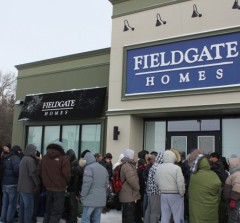Even during wholly prosperous times publicly subsidized sports stadia are a bad idea. The literature is clear on this as I have shown previously. Despite the body of work demonstrating that building sports stadia does little-to-nil for the local economy, every few months another politician in North America trots out drivel in favour of robbing their constituencies purse to erect a monument in honour of their ignorance.
When you integrate financial realities of these projects with the current macroeconomic environment of high debt levels (individuals & public/municipalities) and poor household disposable income growth, its obvious that private businesses should finance these infrastructure projects, not taxpayers.
Seattle: Politicians Seeking Fame & Notoriety.

Private investor Chris Hansen and his yet-to-be-revealed partners have proposed building and operating a pro basketball and hockey arena in Seattle’s SoDo area.
Minor flaw in their plan: they don’t have the money to fund these ambitions. Rather they are attempting to coerce the public into subsidizing their arena-building endeavour “in the form of municipal bonds totaling hundreds of millions in public debt backed by local governments.”
Analysts from UBS visited the discussion with a lengthy piece on the merits of investing in the bonds that are created to finance sports stadia construction. Generally, they conclude in an almost conciliatory statement what readers of this blog have long known:
“Unfortunately, independent academic research studies consistently conclude that new stadiums and arenas have no measurable effect on the level of real income or employment in the metropolitan areas in which they are located”
“There is no broad economic benefit from most sports stadia, rather public financing props up the ever-inflating value of privately-owned sports teams”
They go on to discuss the ‘Cycle of Construction’ of sports stadia and describe how politicians are increasingly captured by the sexy appeal of being a ribbon cutter. Despite most sports stadia being privately owned prior to WWII:
“Many of the stadiums built after the Second World War were abandoned in favor of more modern facilities. By the end of 2012, 125 of the 140 teams in the five largest professional leagues (NFL,MLB, NBA, NHL, and MLS) will play in stadiums constructed or significantly refurbished since 1990.”
The majority of these projects are financed with public funds. To ensure the public play along in this income-redistribution scheme, the cities pump out feasibility studies propagating mythical economic realities. The flaw in these studies is explained perfectly:
Feasibility studies for professional sports facilities often fail to account for the substitution effect. Individuals generally maintain a consistent level of entertainment spending so money spent on sporting events typically comes at the expense of cash spent in restaurants, on travel, and at movie theaters.
The substitution effect is particularly meaningful during a deleveraging period in which average consumers have limited disposable income. The piece-of-the-pie allocated to traditional entertainment is very low for most families in 2012.
That means that after taxes, debt repayment, food and other mandatory costs-of-living these 40-50x yearly events (41 reg seasons game for NBA/NHL teams) far too often run under capacity. This is why leagues are embroiled in revenue sharing agreements that suck profits out of the successful teams to subsidize the fiscal laggards.
As the majority of revenue for the NHL/NBA is gate-driven its paramount to understand how butts in the seats equal profits. In other words, household disposable income growth + winning = financial prosperity.
[Aside: In contrast to the NFL who can support its bottom quartile teams with their share of the enormous TV-related revenue. As some have speculated, you could host NFL games (8-10x annual events) in a 3000-seat TV studio-turned-arena and they would still be the most profitable sports league in North America.]
Cost Centres Breed Taxation
The debts created to build these stadia are repaid primarily by created new taxes. For example, hotel & rental car surtaxes are implemented on all visitors, and boosted general sales taxes increasingly cast an accretive net over the money spent by non-sports-fan consumers in town for business or leisure. This additive disincentive is hardly a means to improve commerce in a given municipality over the long run, a fact which is either misunderstood or ignored by the folks who approve these stadia deals.
When the public demands more due diligence, like they have in Markham, the council slams the door on transparency in the name of expedition. Rather than allow all the members of council to become involved in the process, they have voted for a smaller, more nimble special committee to go ahead and call the shots:
Deputy Mayor Jack Heath expressed anxiety about the “urgent” nature of the project and the tight timeframe required to have the facility finished by fall 2014.
“We need to get going on this,” Mr. Heath said.
The lack of incentives for civic leaders to spend wisely has never been more apparent. Sports fans and citizens alike should not allow these actors to allocate their tax dollar on toys, when the funds are spent much more productively on roads, bridges and public transit.
I guess everyone is comfortable paying higher property taxes so long as owners and athletes come to town and pocket the difference? Probably not, but prudence and logic will not stop these impregnable project from being undertaken at the peril of the community.
 (or index funds) over the long term.
(or index funds) over the long term.












